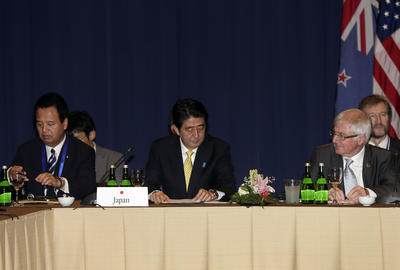In fact, as Asia develops fast, there is a growing tendency for the two terms to be merged together.
There are three main motives for countries to participate in such forms of economic cooperation. All of them are derived from the pursuit of stable and prosperous development.
The first motive is immediate economic interest. The rise of Asian economies has been drawing the world’s attention, especially following their quick recovery from the global financial crisis. But their success has been a long time coming: developing economies in Asia have enjoyed higher and relatively more stable economic development since the end of the Cold War, and the GDP gap between the United States and Asia’s emerging economies has been shrinking since the 1990s. Under circumstances such as these, the whole world has looked to Asia in order to share in its rise.
The second motive is the construction of preferential mechanisms. Economic cooperation in the Asia Pacific is based on a history of functional cooperation, and different types of mechanisms reflect different countries’ interests (or the interests of a particular group of countries, like ASEAN). The complexity of economic participants in the Asia Pacific determines the noodle bowl-like effect of regional mechanisms.
The third motive is the search for dominance over regional economic order, with an end goal of preferential economic rules to secure long-term prosperity. At present, the United States is dominating the world economy, while China, Japan, ASEAN and other players are important cooperators.
Following on from these motives, there are three main types of cooperation: from easy to difficult (for example, the economic cooperation between China and ASEAN), from bottom to top (such as Japan’s economic partnership agreements with regional countries), and non-binding high-level coordination (through forums like APEC). Each of these has special features, advantages and defects. The easy-to-difficult arrangement is suitable for cooperation between two sides with rapid growth. It is flexible and allows gradual liberalisation and further changes in bilateral cooperation. However, one may find it hard to break through existing obstacles, or to coordinate external factors when the open economies of China and ASEAN are affected by world economic conditions.
The bottom-to-top type is a typical institutionalisation of functional cooperation, where Japan possesses deep economic links with regional economies. The cooperation arrangements are systematically designed to promote pragmatic cooperation. This feature strengthens the existing economic structure, where Japan is in an advanced position. However, it neglects calls for change, and is largely inward-looking. APEC and the non-binding high-level coordination mechanisms were a historic achievement after the end of the Cold War, to connect two sides that were previously separated. It shows the great political support for regional cooperation; yet it still disappoints for its non-binding outcomes that encourage sluggish progress.
To make up for the imperfections of existing cooperation mechanisms, two new frameworks have emerged.
One is the Trans-Pacific Partnership (TPP). It has evolved out of APEC, and its binding framework is an improvement on this arrangement. It also provides a channel for the United States to engage more with emerging economies in the Asia Pacific. However, other countries, even developed ones like Australia, find that the ‘high standards’ of the TPP are essentially ‘American standards’, which may cause problems for the region’s developing economies through knee-jerk reforms.
The other new mechanism is the Regional Comprehensive Economic Partnership (RCEP), which is based on the ASEAN Economic Community and is open to any economy with free trade relationships with ASEAN. RCEP recognises the divergence of regional economies, and enjoys a solid basis in existing mechanisms. These features enhance people’s confidence in it. But participating countries have not yet figured out any clear roadmap for negotiations, and whether there will be a successful and functional ASEAN Economic Community is also uncertain.
Some scholars and government officials argue that a framework merging the TPP and RCEP would present the most ideal form of economic cooperation within the Asia Pacific. However, this would be extremely difficult, if not impossible. The two mechanisms coexist with different functions, and were designed for different purposes. The TPP will likely introduce a new system of standards and rules within multilateral mechanisms, while RCEP may set an example of emerging economies’ cooperation, while focusing on the pragmatic promotion of development and a respect for the divergence of participants. To this end, regional governments should join together to maintain an open mind on the development of regional mechanisms and make use of them as a means of stimulating the real economy.
Song Yinghui is a research fellow at the Institute for South and Southeast Asian and Oceanian Studies, China Institutes of Contemporary International Relations.

